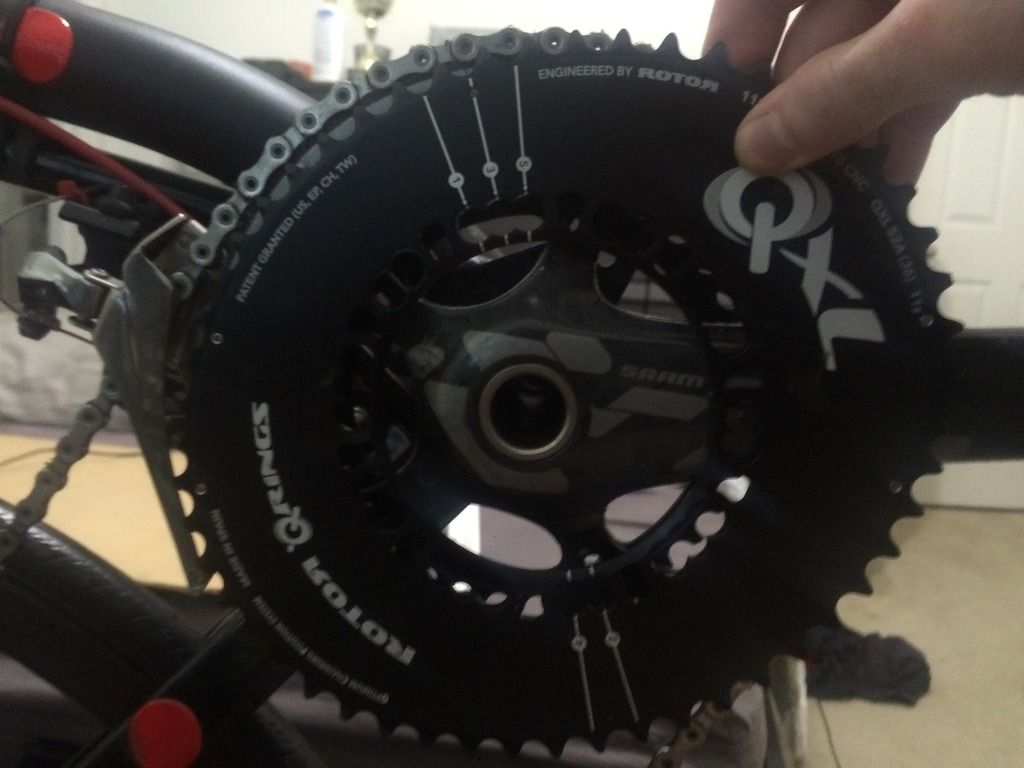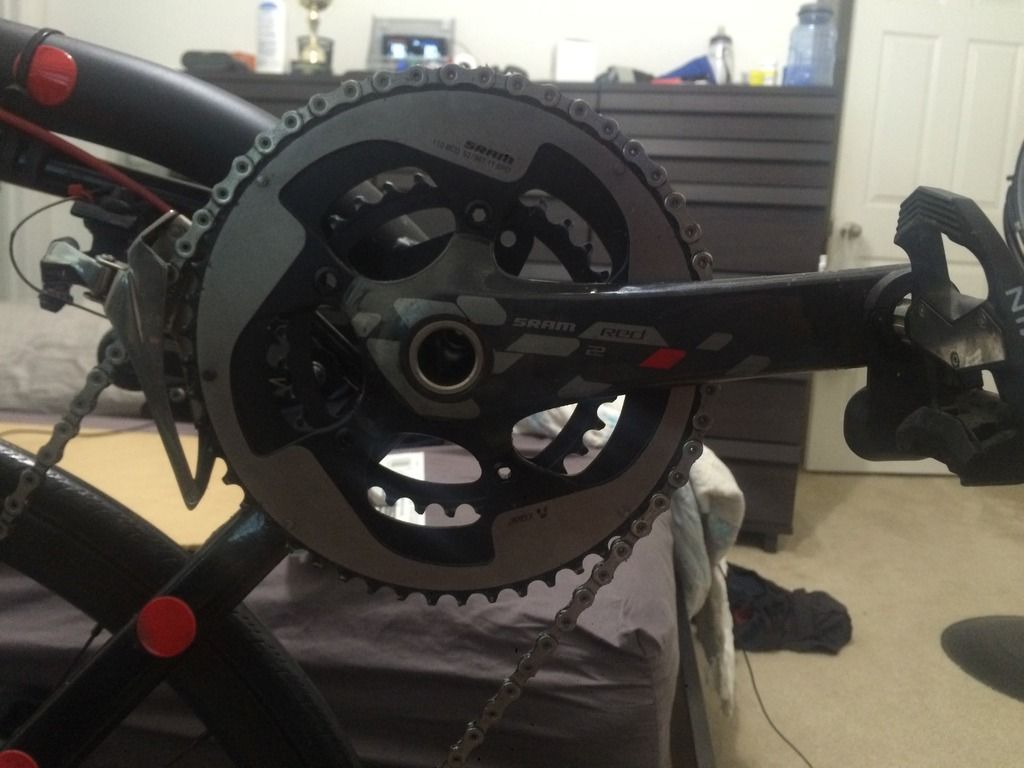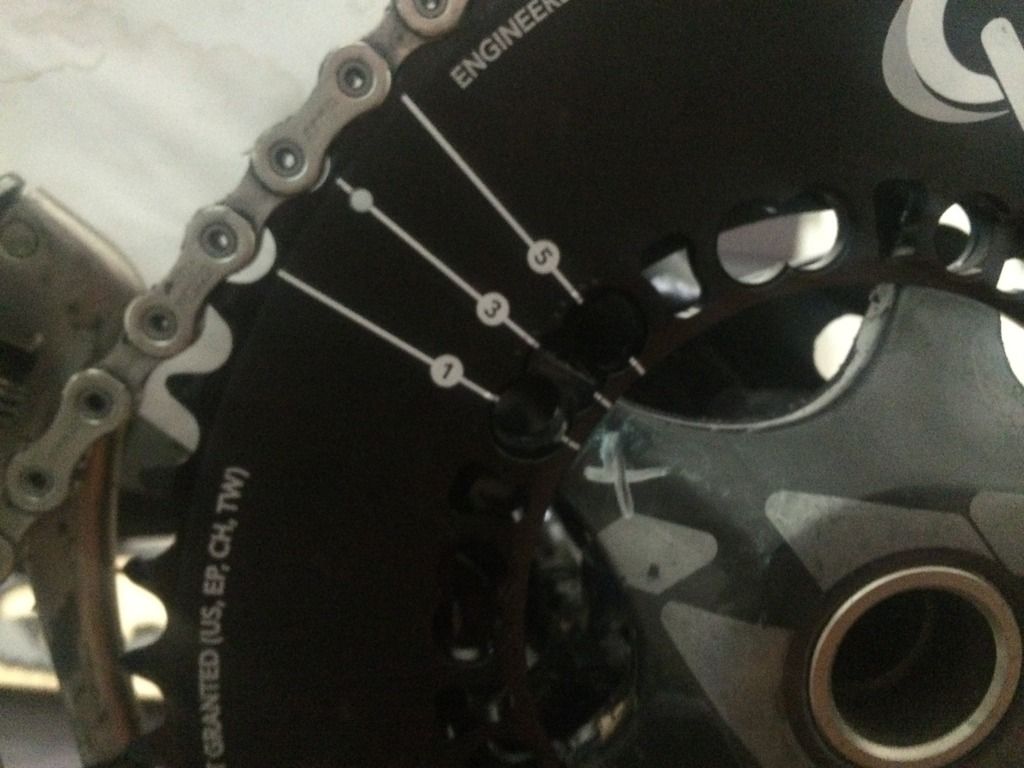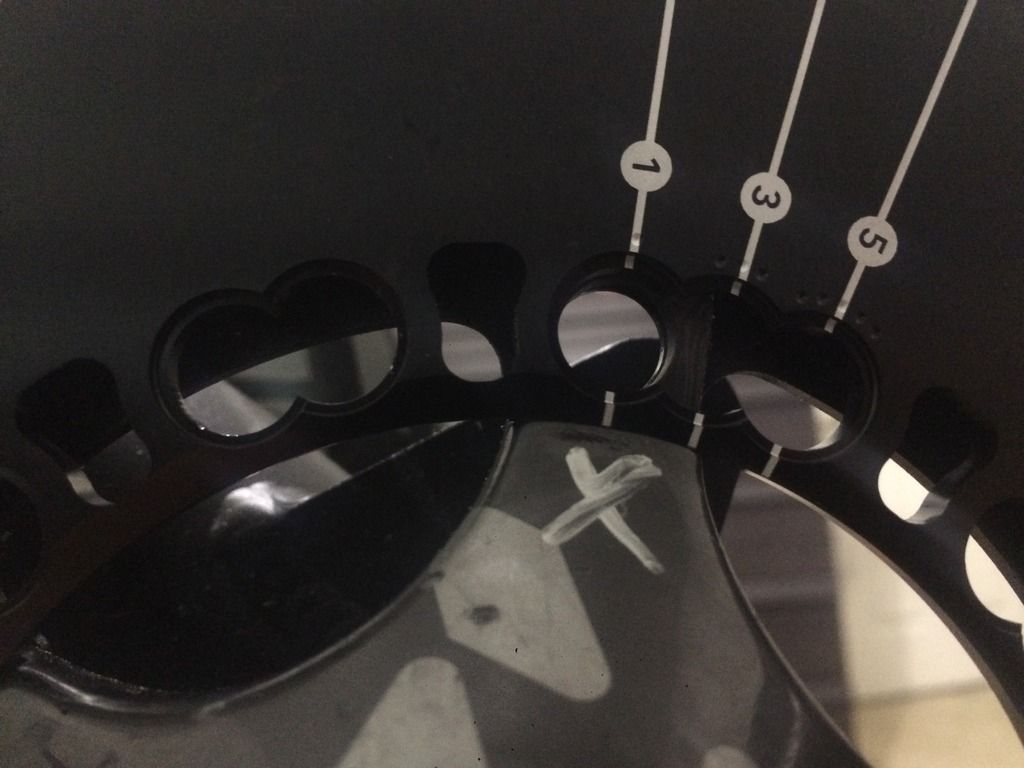Joe, I was probably being a bit too shorthand. I agree with the more in depth thoughts you posted. My simpler point was that short crank arms reduce the time and size of the dead spot by virtue of the smaller diameter. Ovals meanwhile reduce the effort in the dead spot. Both lower the strain on the legs and lead to better long term power conservation. High rpms also does this somewhat.
So When Larry tests these on his 10mm cranks oops I mean his 140mm cranks (we are suppose to talk about the 10mm ones). These tests conducted at 100rpm show not much difference between round and oval. My hypothesis is that the cranks are so short and the rpms so uniquely high that the difference between round and oval are smaller than the error % in the simple on the road testing apparatus.
So this becomes one of the rare cases I go with what the math says and what precieved exertion tells me, because I think that is the best test we can currently afford. I do know this, with a 34round/32 I can't climb the biggest high around here. But with 36qxl/30 I climb much bigger in Portland, but that might have also been not wanting Larry to bet me to the top. Helps that he was on a loaner bike and I was not.
Most of my thoughts are not original on this topic they come from talking to Mark Stonach at bikesmithdesign about what his experience with TT athletes has taught him. He'll tell you the you can use either short cranks or qrings, but on a recumbent when possible combine them. Unfortunately that's far too long a conversation to recount and once again purely subjective
Ratz,
In trying to get to the bottom of the non-round chainring effect, here are some additional thoughts. I have to think this through by writing it out. And some thought experiments may also be required. This is rather lengthy, so schedule some vacation time now before you continue.
You said, "short crank arms reduce the time and size of the dead spot by virtue of the smaller diameter". My understanding of this claim is that the knee angle does not go below (approximately) 90 degrees. Therefore, the "dead spot" is consequently reduced by allowing the leg to extend from a more powerful (more advantageous) position. For example, the leg extension may start at 90 degrees instead of 75 degrees, resulting in more time spent in a powerful extension. This is because the "downtime" of the quads and related muscles would be reduced. Which means that less time would be spent in the "dead spot". It appears we agree on this point.
You said, "Ovals meanwhile reduce the effort in the dead spot". My understanding of this claim is that an oval chain ring would compensate for the non-level mechanical advantage as the leg extends from beginning (around 90 degrees) to full extension (around 170 degrees). The non-level mechanical advantage is a sum of the two things. First, the leg's mechanical advantage changes from minimum to maximum as it travels from most bent to least bent. This can be demonstrated, by the way, by performing squats with a barbell on one's shoulders. Squatting to a leg angle of 170 degrees allows one to lift more weight than squatting to a leg angle of 90 degrees. I don't know if a graph of this would be a straight line or if it would be curved (convex or concave). But it seems to be roughly linear at least. Second, the crank arm (of any length) travels through one-half of a revolution as one leg extends from minimum to maximum extension. At minimum extension (the leg is bent the most), the force on the pedal is directly into the crank (parallel to the crank), so that the resulting torque is zero, which means that the crank rotation is purely from momentum (and possibly pulling up) at this point. As the crank arm rotates for the next 90 degrees, the mechanical advantage of any force applied to the crank arm changes from zero percent at parallel to 100% at perpendicular. And, due to trigonometry, the mechanical advantage changes in the form of a sine wave. As the crank arm rotates from 90 degrees to 180 degrees, the mechanical advantage is reversed in the form of a sine wave from 100% at perpendicular (half extension of the leg) to zero percent at parallel (full extension of the leg). So, there are two mechanical advantages that can be graphed as 1) a line going from lower left to upper right in a roughly-straight line for the full leg extension; and 2) a sine wave starting at the lower left, maxing out at the halfway point in the extension, and dropping back to zero at the right side of the graph. If we draw a graph of the sum of the two mechanical advantages, we should see the first half as roughly linear and increasing from lower left to upper right. But at the halfway point we see one line is going up and the other is going down. If they cancel each other out, we see that the second half of the leg extension is roughly horizontal, which means that the muscle fiber activation is roughly consistent throughout the entire second half of the leg stroke. So it's the first half of the leg extension that needs help. This is where a non-round ring should help out by leveling out the mechanical advantage of the first half of the leg extension. A non-round ring would do this by changing the diameter of the chain ring, as if it were a continuously variable transmission. It appears that we agree on this point also.
Speaking of muscle fiber activation, this raises a question of purpose. What are we trying to accomplish with non-round chain rings? One answer would be more power. But what does that mean? To get the same drive wheel torque in the first half of the leg extension as in the second half, the leg muscle would have to work harder (activating more muscle fibers). This imbalance can be thought of on a scale, but it could entail activating too many muscle fibers in the first half and just the right amount in the second half. Or it could mean activating just the right amount in the first half and too few in the second half. Or it could mean consistent muscle fiber activation throughout the entire leg extension by sacrificing smooth drive wheel torque, and thereby wasting energy (this is probably a less common option). It seems that, for maximum efficiency, we would want to maintain our drive wheel torque, but even more importantly, we would want to keep our muscle fiber activation consistent throughout the entire leg extension. This way, we can conserve our limited glycogen stores as much as possible, which means that we can get more energy aerobically from fat. Which means we can get the same amount of driving power for a longer time. So maybe non-round rings allow us to be more efficient in a physiological sense, which translates to a given power output for a longer time (as opposed to getting a higher power output for a shorter time). The reason efficiency is important is because power output will drop when glycogen stores are depleted. So keeping a level mechanical advantage throughout the entire leg extension allows a consistently level muscle fiber activation, which yields the maximum power output over a long time (such as hours). But what about hills? The same effect would be present. It's just that the (primarily) anaerobic power output would be most efficient, thereby using up less glycogen than with round rings. Keep in mind that aerobic and anaerobic power output is a sliding scale, where power output becomes more anaerobic (and less aerobic) as the power output increases. In a highly trained muscle, the aerobic power output can be higher than for a lesser trained muscle. But at higher power outputs, the highly trained muscle will still burn glycogen like a wild fire. The difference is that the highly trained muscle will buffer the hydrogen ions (not lactic acid as is commonly misunderstood!) (thereby limiting the burning sensation) and allow the anaerobic power output to continue, whereas a lesser trained muscle will fail at some point (power output drops, as much as all the way to zero) until it recovers. Athletes with highly trained muscles have the advantage of staying more aerobic at any given power level, thereby conserving even more glycogen. So any athlete would benefit from a more efficient power output and would also benefit with any given combination of aerobic and anaerobic power output. The bottom line is that non-round rings should, in theory, extend aerobic power output by getting more power from fat over a long distance as opposed to round rings, which would get less power over a long distance from fat. I say "long distance" because we all probably have enough glycogen to last a while, since we all ride a lot. This efficiency should also translate to better long distance race results.
How to measure the effect? If the given technology is having trouble measuring the effect of the drive wheel torque due to high rotational velocity of the pedals, cranks arms, bottom bracket, or drive wheel, then an experiment could be performed where the resistance to the drive wheel is increased enough to slow down the drive wheel rotation so that the drive wheel torque could be accurately measured. This would measure the output effectively, but then a method of measuring the input would also have to be devised. This would probably mean measuring oxygen in, carbon dioxide out, and force to the pedals throughout each pedal stroke. The graph of the force to the pedals should match the graph of the mechanical advantage of the leg stroke. That is, the force should increase linearly from least force to most force over the entire leg stroke as the mechanical advantage of the leg increases from least to most. That's assuming the muscle fiber activation remains the same throughout the stroke. (This would also give a measurement of the leg's mechanical advantage that could be compared to a calculated mechanical advantage.) If it were possible to measure the muscle fiber activation throughout the stroke, that would be very useful also. I don't know if that's possible. And then there is the drive wheel torque (the system output) which could easily be measured throughout the leg stroke. We would expect the drive wheel torque to be consistent throughout the leg extension, but would probably drop at the end of each stroke (which is the beginning of the next stroke). But most of the leg stroke should create a fairly level drive wheel torque. The bottom line on this system effect throughout the leg stroke is that the graph of the muscle fiber activation should match the graph of the drive wheel torque because internal components (mechanical advantages of leg angle, crank arm torque, and non-round chain ring) work together to create a fairly level graph of each. The consistent muscle fiber activation creates the benefit of physiological efficiency, thereby extending a given power output over time. The force to the pedals over time and the distance traveled (by the drive wheel on a roller) vs. the oxygen use and carbon dioxide production should tell us how efficient the non-round chain ring system is compared with a round chain ring system.
Small non-round chain ring? I remember that you suspected the small non-round chain ring would have a lesser effect than the large non-round chain ring. I think the effect would be identical as long as the shape and ratio of the two non-round rings are exactly the same. That is, only the size would change. Think of it this way. Traveling on a flat course at over 30 mph at 90 rpm on a given surface requires a certain power output. Lets assume we can measure the muscle fiber activation. Now, alternatively, lets travel up a hill with a given grade and surface at 7 mph and 90 rpm so that our power output is the same. Our muscle fiber activation should also be the same. If we measure the graph of our muscle fiber activation, it should also be level in both cases - in fact it should be identical. Why is this? Because the sum of the mechanical advantages (from leg angle, crank arm angle, and especially the chain ring ratio) is the same in both cases. We might be using a different cog, but if the small ring is tuned to a large cog so that the tangent is the same as the large ring with a small cog, then the specific cog in either case will make no difference. So what changed other than the ring size? The resistance changed from wind resistance at over 30 mph to gravity going uphill and lifting bike and body weight. Since the gravity creates greater resistance than the wind in this scenario, the speed has to change, and therefore the chain ring changes, but the legs can't tell the difference. To the legs, the mechanical advantages together allow a smooth muscle fiber activation in both cases and the same graph of force to the pedals over the leg extension. The bottom line here is that the small ring will create the same advantageous effect as the large ring, but it would be used for climbing instead of for all out speed.
The bottom line of this whole non-round chain ring issue is that non-round chain rings (both large and small) should create a beneficial and measurable systemic and physiological effect that will be advantageous for climbing, for speed, for long duration events, and for racing due to physiological efficiency. The trick is to determine the specific ring shape for a given person through math, and then prove it through measurement.







